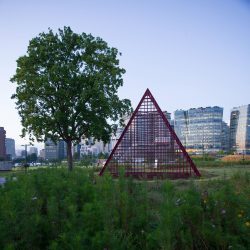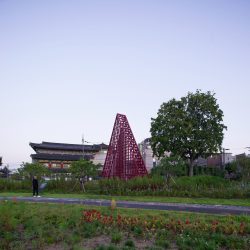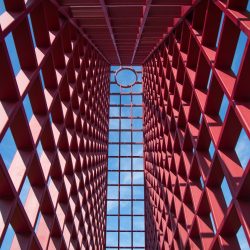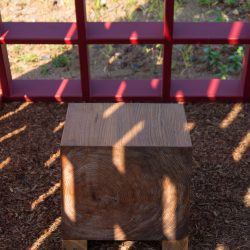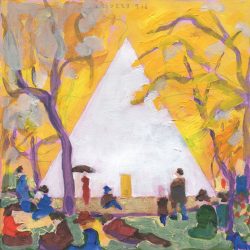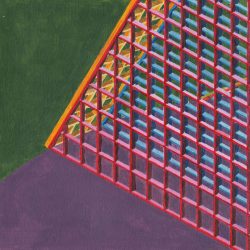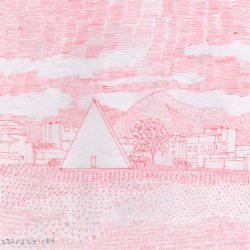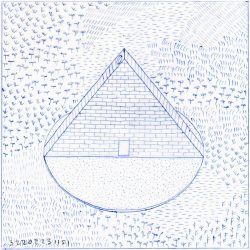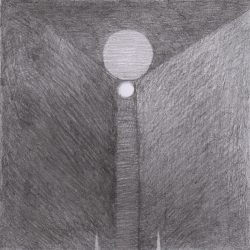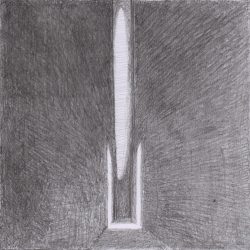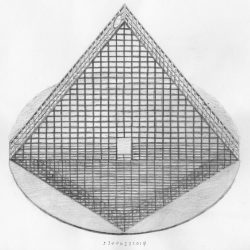
Pezo von Ellrichshausen . photos: © Pezo von Ellrichshausen
Before any social contract and right after our supposed subjective singularity, there is an individual mirrored in another individual, that is: a couple.
This unified character, synthesized in the double portrait (from Van Eyck to Hockney), is the idealized and certainly romantic inhabitant for this enigmatic piece. Its figure, a stable equilateral triangle with almost no thickness, a kind of scaleless and building-less pediment, becomes the theatrical setting for a dramatic double relationship: facing its only access, through a projection beyond its interior, turning the facade into a threshold between here and there; once inside, the projection becomes a direct, intimate, and inevitable relationship between one person and another at the opposite end.
Who are they? Maybe a real couple (a mother and her son, two friends, or two strangers), perhaps a fictional couple (one and their dreams, idols, or shadows).
The pavilion is certainly a space separate from the everyday world. It is a room for two, a resting place, a meeting space, a void filled with tension. A vertical division, a gap in ordinary life, simply transfigured into a supernatural domain, even into a superstition, appears through an asymmetric peephole cut against the sky, occupying the unreachable corner of the interior. Such is the tension within this compact artifact.
From a distance, its regular silhouette exudes a discreet sense of monumentality, not only as a sign of itself but as a landmark outside of time. In explicit contrast with the surrounding landscape, its mirrored cladding (in a regular pattern of stacked stones) aims to reveal the subtle moods of the local climate. Eventually, this flat figure will become a screen; the sun on the snow or a frozen pyramid for the summer season.
*Note: The pavilion is conceived in two stages; a temporary installation in the urban context of the Seoul Biennale of Architecture and its complete recycling for the permanent installation in a new botanical garden in Gyeonggi Province.
_
Antes de cualquier contrato social y justo luego de nuestra supuesta singularidad subjetiva, se encuentra un individuo espejado en otro individuo, esto es: una pareja. Este personaje unificado, sintetizado en el retrato doble (desde Van Eyck a Hockney) es el habitante idealizado, y ciertamente romántico, para esta enigmática pieza. Su figura, un estable triángulo equilátero casi sin espesor, una suerte de pedimento sin escala y sin edificio, pasa a ser el escenario teatral para una dramática relación doble: frontal a su único acceso, mediante una proyección más allá de su interior, haciendo de la fachada un umbral entre aquí y allá; una vez dentro, la proyección se convierte en una relación directa, íntima e inevitable entre una persona y otra al extremo opuesto. ¿Quiénes son? Tal vez una pareja real (una madre y su hijo, dos amigos o dos extraños), tal vez una pareja ficticia (uno y sus sueños, sus ídolos o sus sombras). El pabellón es ciertamente un espacio fiera del mundo cotidiano. Es una habitación para dos, una sala de descanso, un espacio de encuentro, un vacío lleno de tensión. Una división vertical, una brecha en la vida corriente, simplemente transfigurado en un dominio supernatural, incluso en una superstición, aparece mediante una mirilla asimétrica recortada contra el cielo, ocupando la única esquina inalcanzable del interior. Tal es la tensión dentro de este compacto artefacto. A la distancia, su silueta regular exuda un discreto sentido de monumentalidad, no sólo como signo de si mismo sino cómo hito al margen del tiempo. En contraste explícito con el paisaje circundante, su revestimiento espejado (en un patrón regular de piedras apiladas) pretende revelar los humores sutiles del clima local. Eventualmente, esta figura plana pasará a ser una pantalla; el sol en la nieve o una pirámide congelada para las temporada estival. *Nota: El pabellón está concebido en dos etapas; un montaje temporal en el contexto urbano de la Seoul Biennale of Architecture y su total reciclado para la instalación permanente en un nuevo jardín botánico en la provincia de Gyeonggi.

